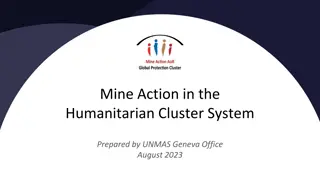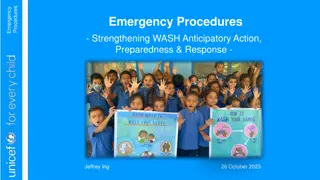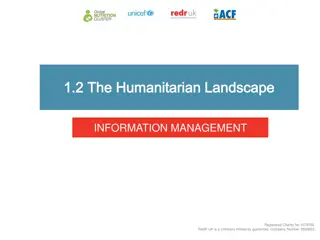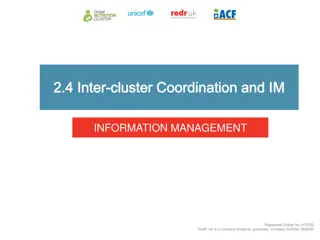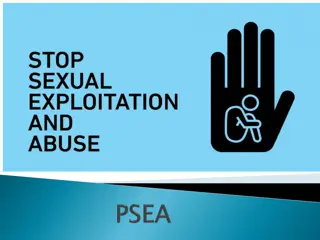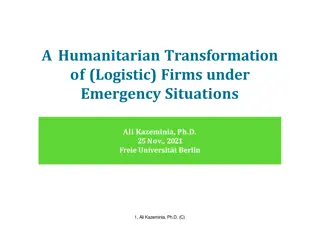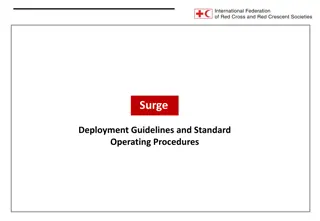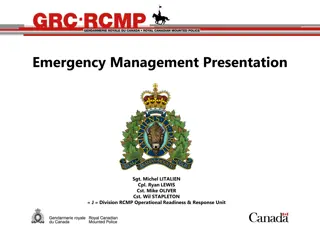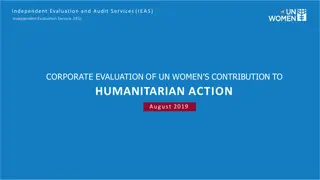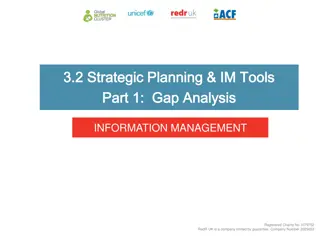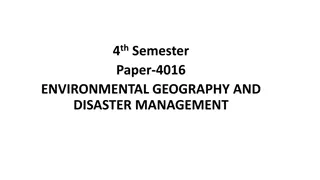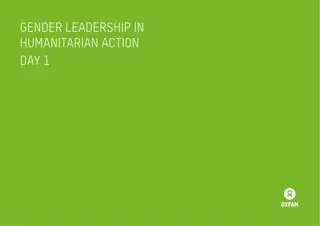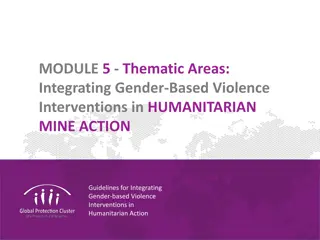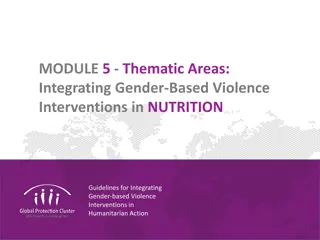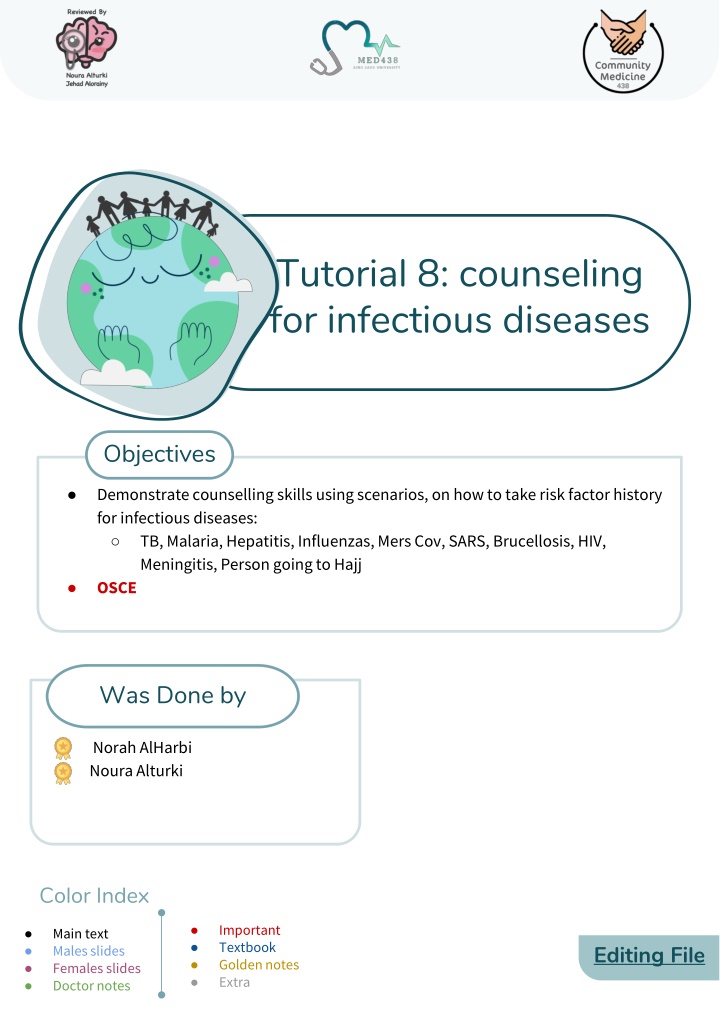
Humanitarian Response to Emergencies: Key Principles, Funding, and Roles
The international humanitarian system involves various organizations, agencies, and funding mechanisms to provide assistance during emergencies, guided by fundamental principles. Learn about UN agencies, the Red Cross Movement, funding mechanisms, and roles in emergency response.
Download Presentation

Please find below an Image/Link to download the presentation.
The content on the website is provided AS IS for your information and personal use only. It may not be sold, licensed, or shared on other websites without obtaining consent from the author. If you encounter any issues during the download, it is possible that the publisher has removed the file from their server.
You are allowed to download the files provided on this website for personal or commercial use, subject to the condition that they are used lawfully. All files are the property of their respective owners.
The content on the website is provided AS IS for your information and personal use only. It may not be sold, licensed, or shared on other websites without obtaining consent from the author.
E N D
Presentation Transcript
Tutorial 8: counseling for infectious diseases Objectives Demonstrate counselling skills using scenarios, on how to take risk factor history for infectious diseases: TB, Malaria, Hepatitis, Influenzas, Mers Cov, SARS, Brucellosis, HIV, Meningitis, Person going to Hajj OSCE Was Done by Norah AlHarbi Noura Alturki Color Index Important Textbook Golden notes Extra Main text Males slides Females slides Doctor notes Editing File
What is Counselling? A Support process in which a counselor holds face to face talks with another person to help him or her solve a personal problem, or help improve that person's attitude, behavior, or character. The act of helping the client to see things more clearly.To reach a decision Aim: Disease Prevention Primary prevention Secondary prevention Refers to efforts to eliminate health or functional problems at their source that is, preventing their occurrence, (such as immunizations, improving nutritional status, and increasing physical fitness and emotional well-beingthat reduce the incidence of disease or render a population at risk not vulnerable to that risk. Involves efforts to detect adverse health conditions early in their course and to intervene promptly and effectively, or to reduce the spread of disease to others or complications Standard Precautions-Key Steps Frequently wash hands or use alcohol-based handrubs. Use gloves. Wear an apron, mask, and eye protectors, as necessary. Properly handle and dispose of possibly infected linens and wastes. Properly handle and dispose of sharp instruments, such as needles.
Bloodborne and other common infectious diseases: Other Common Infectious Diseases:: 1 2 Bloodborne diseases: Bacterial: HIV/AIDS. Hepatitis B and C. Staph skin infection. Pneumonia / TB Parasitic Giardia diarrhea. Viral: COVID-191 Influenza, or the flu. Respiratory infections. Hepatitis A infection. Diarrhea. Chickenpox, measles, mumps. Understanding How Infectious Diseases Spread Where Infection Lives Blood or Body Fluids: Urine Feces Tears Sputum Saliva Food Water Organic matter Pets Pests Vomit Sweat Semen Vaginal fluid 1. Transmitted by droplets or even touch
Pathways Through Which Infectious Diseases Spread Breathing spray from coughs, sneezes, talking and this is the main way for transmission of COVID-19 Being stuck by a sharp with infected body fluids. Being bitten by animals and insects, or by coming into contact with animals body fluids. Eating, drinking, or handling infected food, water, or dirt. Touching infectious people or surfaces, objects, clothing, and linens that carry body fluids. Who is at Most Risk of Becoming ill When Exposed to Infection? Anyone CAN be at risk! Babies, children, and elders. People who are sick DM RA CTD pre-existing conditions and weak immune systems. Ppl who don t eat a healthy diet. poor personal hygiene or living conditions. Stay up it's ok we all gonna die someday =) Ppl who don t wash their hands often Now it's one of the main way to limit transmission of COVID-19 along with mask over-tired or stressed. To Counsel for infectious disease: know each one for OSCE Take history of: Exposure Symptoms Precautions: Measures should be taken for the infected person Which symptoms he or she came with When and how exposed Prophylaxis Prevention Either primary or secondary prevention For which prevention he or she came for
Cases and questions: A 26-year-old woman presents to clinic for advice as her brother is recently diagnosed as a case of hepatitis A 3 days ago. She asked for any intervention as she never received any vaccination for hepatitis before. case1 How are you going to counsel her? 2 Start vaccination: 1 Hygienic measures: For Hepatitis A and better immunoglobulins2 Hand washing, Limiting contact with him, Don t share his personal items, Avoid sharing1drinking glasses or dining utensils. Isolation in one room A 32-year-old male married and has 2 children came for pre-employment check up. The following hepatitis B markers are shown: case2 Hepatitis B S antigen3...... Reactive Anti-Hepa B Core lgG4....... Reactive Hep-B e Antigen........... Reactive Anti-Hepa B e Antigen5 Nonreactive Anti-Hepa B Surface6....... Nonreactive He has chronic hepatitis B virus as Core IgG is reactive or positive He is highly infectiousas e antigen is reactive or positive 1. 2. 3. 4. 5. That's why we advise to use disposable one For higher exposed The infectious agent Means it's old more than 6 months High viral load indicates viral activity (highly infectious) 6. Indicates Immunity
1 Measures for the patient: 2 Measures for contacts Break the news for the patient / Ask for a source of infection1/ exposure. Ask about vaccination of children, Screen family contacts if they are immune or not and start vaccinate the non immune ones. Request Liver function tests, Ultrasound liver, PCR, Referral to hepatologist. Educate how to be careful in contact with body fluids, inform him that the infection could be transmitted through mainly blood, Protective measures for relation with his wife, No blood donation. A 42-year-old man presents with one day H/O fever, sneezing and cough. He used to go his farm, which has camels and sheep. The nurse in vital signs informed you that we may have a case of Corona virus. An outbreak of corona virus (MERS-CoV) is running. case3 What general as well as specific measures should be taken? Take steps to ensure all persons with symptoms of a respiratory infection adhere to: Respiratory hygiene Cough etiquette, and Hand hygiene. Wear a mask / Cover your mouth and nose with a tissue when coughing or sneezing. q Use in the nearest waste receptacle to dispose of the tissue after use. Consider posting visual alerts (e.g. signs, posters) in strategic places (e.g., waiting areas, elevators, cafeterias) to provide patients and HCP with instructions (in appropriate languages) about hand hygiene, respiratory hygiene, and cough etiquette. Provide supplies to perform hand hygiene to all patients upon arrival to facility (e.g. at entrances of facility, waiting rooms, at patient check-in). Personal Protective Equipment (PPE): Gloves, Gowns, Respiratory Protection (N95 filtering facepiece respirator) and Eye Protection (eye goggles) Patient Placement:Place a patient who might be infected with MERS-CoV in an Airborne Infection Isolation Room (AIIR) Take a nasopharyngeal swab (If positive, Isolate and treat) and (if negative, reassure and discharge) Isolation for cases: for 10 days or 72 hours after the fever and respiratory symptoms disappear whether at home or in quarantine facilities. 1. Important for OSCE as you may ask about the source of Infection: operation, dental procedures etc
You are entering the room of a patient with confirmed MERS-CoV. What precautions you should adhere to? Standard, Contact, and Airborne precautions, including the following: Hand Hygiene Personal Protective Equipment (PPE): Gloves Gowns Respiratory Protection (N95 Mask) Eye Protection (eye goggles) You have seen a 46-year-old man came for advice regarding malaria protection as he will travel after a week to a country endemic with malaria in Africa and will stay for 2 weeks. case4 How are you going to counsel him? Specific (Chemoprophylaxis): General: Proguanil (Malarone):Begin 1-2 days before travel, 1 tablet daily during travel, and for 7 days after leaving. Mefloquine: 1 tablet weekly. Begin 1-2 weeks before travel, weekly during travel, and for 4 weeks after leaving. Doxycycline:Begin 1-2 days before travel, daily during travel, and for 4 weeks after leaving. No antimalarial drug is 100% protective and must be combined with the use of personal protective measures, (i.e., insect repellent, long sleeves, long pants, sleeping in a mosquito-free setting or using an insecticide-treated bednet).
A 56-year-old man came to you as planning to go to Haj. He asked is there any vaccines he should take and how to protect himself in crowded Tawaf. case5 Which disease are you afraid from other than flu? Meningitis1 Which Immunoprophylaxis are you going to give? Vaccination is used for meningococcal disease due to A, C, Y, and W serogroups (MCV4). How to protect himself in Tawaf? Putting a face mask to protect against any nosocomial infections. Chemoprophylaxis (when there is probability of presence of cases) Person-to-person transmission can be interrupted by chemoprophylaxis, which eradicates the asymptomatic nasopharyngeal carrier state. Rifampin2, Ciprofloxacin, and Ceftriaxone are the antimicrobials that are used to eradicate meningococci from the nasopharynx. A 58-year-old man came with his son because of fever and cough for 3 weeks. A sputum smear was sent and revealed TB bacilli positive. case6 How are you going to counsel him and his son regarding transmission of this infection? Measures for the patient: Patient will put a face mask and should be admitted and isolated. Also should be learned for cough etiquette. Only discharged when 3 consecutive sputum smears are negative. Measures for contacts: Screen by history taking, Quantiferon3, Chest X-ray 1. 2. 3. Influenza could be given also but it is not required For 2 days We do it for ppl with high risk such as healthcare workers
1 What percentage of people living with hepatitis KNOW they are infected? A.Less than 5% B.30 % C.50% D.More than 90% 2 You have a friend who is going to China for 7 months. He leaves in 2 weeks. He has never received either hepatitis A or B vaccines. Which is the best choice today for his immuno-prophylaxis of hepatitis A? A) A dose of hepatitis A vaccine B) A dose of IM immunoglobulin1 C) A dose of IM immunoglobulin and a dose of hepatitis A vaccine D) First dose of hepatitis A vaccine today and a booster dose the day before he leaves 3 What is the most important patient education information to give your friend about avoiding hepatitis A exposure? A) Tell him to avoid sharing needles or using non-sterile needles. B) Remind him about using insect repellent and mosquito netting at night. C) Encourage him to take safe sex precautions. D) Explain good hand washing and food and water precautions. 4 A nurse sustains a needle stick from a patient who is known to be HBsAg-positive. She has been vaccinated previously with hepatitis B vaccine and is a known non-immune (No antibodies). What postexposure prophylaxis should the nurse receive? A) One dose of hepatitis B vaccine. B) One dose of HB immunoglobulins and one dose of hepatitis B vaccine. C) No vaccination but proper cleaning of site of injury. D) Test the nurse for anti-HBs level; treat accordingly. 4)B 3)D 2)A 1)A 1. Given for ppl with high risk of hepatitis
5 Which of the following viral causes of hepatitis is transmitted by contaminated food or water? A) Hepatitis B B) Hepatitis C C) Hepatitis D D) Hepatitis E 6 Hepatitis D is commonly associated with what other type of viral hepatitis? A) Hepatitis A B) Hepatitis B C) Hepatitis C D) Hepatitis E 7 A pregnant woman is known to be HBsAg positive delivered her baby. Which of the following is the appropriate measure has to be taken with her baby? A. Check the baby for hepatitis B markers. B. Start Hepatitis B immune globulin (HBIG) and HBV vaccine within 12 hours of delivery. C. Start Hepatitis B immune globulin (HBIG) and delay HBV vaccine till age of 6 weeks. D. Start with HBV vaccine only within a week after delivery.

